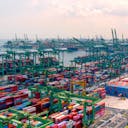It is the document of title, the receipt for shipped goods and the record of agreed terms and conditions. It is most often exchanged in paper format, but this is slow, expensive and environmentally unsustainable. DCSA has published data and process standards for an electronic bill of lading (eBL) and has completed a proof of concept (PoC) trial with platform providers, testing eBL interoperability through the full bill of lading lifecycle using data mirroring a live shipment.We spoke with Bertrand Chen, CEO of Global Shipping Business Network (GSBN), about the significance of the PoC, the results it has seen as well as how a fully interoperable eBL will benefit international shipping and trade.
"The bill of lading serves a number of very important roles in container shipping."What is GSBN and how did you get involved in the PoC?
GSBN is an independent, not-for-profit technology consortium for the global shipping industry with a mission to support its digitisation. Our shareholders include global carriers and terminals.We operate a blockchain-enabled platform enabling trusted data exchange and collaboration across different parties in global supply chains. IQAX eBL is a third-party application which has been built on our platform and has been a part of this latest PoC.Why do you think the eBL PoC interoperability collaboration is important?
Although the first electronic bill of lading solutions were introduced over 20 years ago, we are yet to witness wide adoption. More recently, blockchain-based eBLs have been successfully launched. But given that adopting any eBL solution is effectively like joining a network, we are facing a classic cold start problem, where no solution in the market has achieved a strong enough network yet.Banks in particular are very wary about being forced into adopting dozens of incompatible and subscale solutions. The transaction volume would not justify the investment, and operationally it would be a nightmare to handle.This eBL interoperability collaboration is designed to ensure that regardless which eBL solution you adopt today, you will be able to transact with all your counterparties and your banks, regardless of which solution they have chosen.What results have you seen so far?
We were very impressed by the collaboration facilitated by DCSA. By convening meetings between the different solution providers, DCSA is creating an avenue to make interoperability between solution providers a reality.In the first PoC we participated in, a straight eBL was issued on one platform, transferred to the shipper on a second platform, endorsed to the consignee on a third platform, and finally surrendered back to the carrier on the first platform to close the loop.This is truly a remarkable achievement, and it is a testament to the willingness of various solution providers to collaborate in order to grow the pie bigger for the entire industry.What are the lessons learned during this PoC?
During this process, we learned that the technical part of interoperability is perhaps the easiest part. We still need to solve the problem of matching the identity of customers across platforms.The next enhancement would be to separate possession and control for an eBL, which is key for a Letter of Credit use case with banks. Without this feature, eBL would not be able to achieve its full potential as it would not satisfy key scenarios for banks.Another key challenge is the legal aspect of interoperability. As we execute the cross-platform exchanges, we are also identifying the areas where problems may arise and the need to address those risks for legal departments to be comfortable.What are the benefits to your customers once we achieve platform interoperability?
The first benefit is that this will hopefully get us much further along on the adoption curve.The second benefit is that solution providers will need to focus beyond simply offering eBL. There will be myriad ways to think about the business models for eBL solutions (e.g., who pays?), while solutions will become much more specialised and customer centric. Solutions could be built to address the needs of different market segments. For instance, chemicals shippers have very different workflows and needs compared to electronics shippers.Another angle to consider is addressing the needs of the Trade Finance industry. The coordination between buyer, seller, issuing and advising banks can become more paperless and efficient. eBL is one key element, but it is not the only one. The key would be to package this in a highly intuitive fashion for users.What does a fully interoperable eBL mean for international shipping and trade?
McKinsey recently published a research piece on the financial impact resulting from 100% eBL adoption. It is estimated this would result in $6.5 billion in direct cost savings annually for the industry and enable up to $40 billion in increased trade.But beyond merely cost savings, eBL is the first step towards fully digitising shipping processes to make the industry more paperless, digital and low carbon.For instance, the EU funded project eCONBIL by the university of Bremerhaven, with the participation of Kuehne + Nagel, DZ Bank, KRAVAG and MSC proved the benefits of using blockchain technology for CO2 emissions. When converting the paper-based bill of lading process to a blockchain-based process, over 90 percent of CO2 emissions can be saved.In many ways, this is like when the iPhone was first launched and enabled a new class of applications that leveraged the camera, touchscreen, and GPS. This created substantial new value in the tech industry and had profound implications. eBL will be the first killer app for a blockchain network to accelerate digitisation in the shipping industry.Has anything come out of this PoC experience that was perhaps unexpected or rewarding that you want to share with the industry?
I think what was unexpected is the sheer willingness from many solution providers to collaborate and make this PoC a success. In many other sectors, it would be unheard of to see this level of collaboration to grow the entire pie. My hope is that after the different phases of the technical PoC are concluded, we will move at a swift pace for possession and control separation as well as legal interoperability.
Digitalise the container shipping industry
At DCSA, we envisage a digitally interconnected container shipping industry in which customers have a choice of seamless, easy-to-use services that provide the flexibility to meet their business and sustainability goals.









